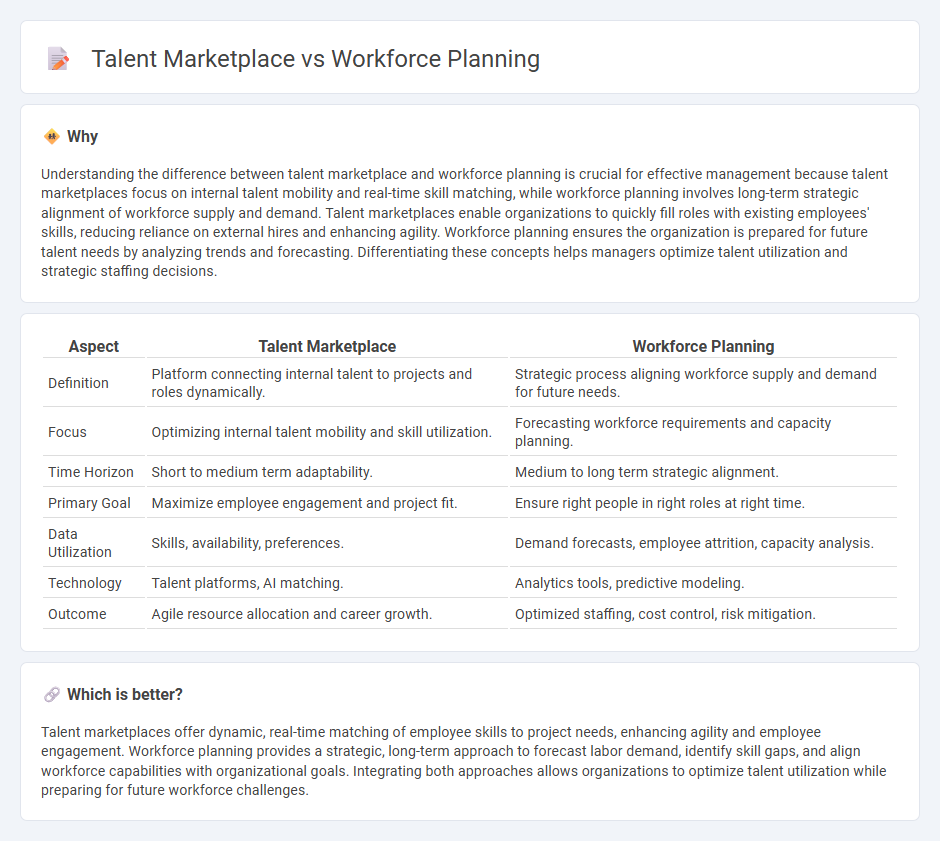
Talent marketplaces empower organizations to dynamically match employees' skills with project needs, enhancing agility and employee engagement. Workforce planning focuses on forecasting future talent requirements and aligning them with long-term business goals to ensure consistent resource availability. Explore how integrating talent marketplaces with workforce planning can optimize workforce management strategies.
Why it is important
Understanding the difference between talent marketplace and workforce planning is crucial for effective management because talent marketplaces focus on internal talent mobility and real-time skill matching, while workforce planning involves long-term strategic alignment of workforce supply and demand. Talent marketplaces enable organizations to quickly fill roles with existing employees' skills, reducing reliance on external hires and enhancing agility. Workforce planning ensures the organization is prepared for future talent needs by analyzing trends and forecasting. Differentiating these concepts helps managers optimize talent utilization and strategic staffing decisions.
Comparison Table
| Aspect | Talent Marketplace | Workforce Planning |
|---|---|---|
| Definition | Platform connecting internal talent to projects and roles dynamically. | Strategic process aligning workforce supply and demand for future needs. |
| Focus | Optimizing internal talent mobility and skill utilization. | Forecasting workforce requirements and capacity planning. |
| Time Horizon | Short to medium term adaptability. | Medium to long term strategic alignment. |
| Primary Goal | Maximize employee engagement and project fit. | Ensure right people in right roles at right time. |
| Data Utilization | Skills, availability, preferences. | Demand forecasts, employee attrition, capacity analysis. |
| Technology | Talent platforms, AI matching. | Analytics tools, predictive modeling. |
| Outcome | Agile resource allocation and career growth. | Optimized staffing, cost control, risk mitigation. |
Which is better?
Talent marketplaces offer dynamic, real-time matching of employee skills to project needs, enhancing agility and employee engagement. Workforce planning provides a strategic, long-term approach to forecast labor demand, identify skill gaps, and align workforce capabilities with organizational goals. Integrating both approaches allows organizations to optimize talent utilization while preparing for future workforce challenges.
Connection
Talent marketplaces enhance workforce planning by providing real-time visibility into employee skills, availability, and career aspirations, enabling organizations to dynamically allocate resources and close skill gaps efficiently. By leveraging data-driven insights from talent marketplaces, workforce planners can forecast talent needs and optimize internal mobility, improving agility and reducing reliance on external hiring. Integrating talent marketplaces with workforce planning systems supports strategic decision-making that aligns talent supply with evolving business objectives.
Key Terms
**Workforce Planning:**
Workforce planning involves analyzing current workforce capabilities, forecasting future talent needs, and aligning human resources with organizational goals to ensure optimal productivity. It emphasizes strategic decision-making regarding staffing levels, skill development, and resource allocation based on data-driven insights. Explore how workforce planning drives effective talent management and business success.
Succession Planning
Workforce planning strategically identifies future talent needs and critical roles to ensure leadership continuity through effective succession planning. Talent marketplaces facilitate internal mobility by matching employees' skills with available development opportunities, accelerating readiness for key positions. Explore how integrating workforce planning with talent marketplaces enhances succession planning effectiveness.
Skills Gap Analysis
Workforce planning identifies current and future organizational skill requirements to address gaps and ensure the right talent is available for strategic objectives. Talent marketplaces leverage internal mobility platforms to match employees' skills with open roles, facilitating real-time skill gap mitigation and career development. Explore how integrating workforce planning with talent marketplaces enhances skills gap analysis for optimized talent management.
Source and External Links
What Is Workforce Planning? Strategies and Benefits - Workforce planning is the process of analyzing an organization's current workforce, forecasting future staffing needs based on internal and external factors, identifying gaps in skills or roles, developing action plans to address these gaps, and continuously monitoring to ensure alignment with long-term company goals.
Workforce Planning: Definition, Process and Principles - Workforce planning involves determining strategic direction, conducting supply and demand analyses of talent, and planning to address organizational needs for skills, qualifications, and workforce changes to support business objectives.
Workforce Planning - Workforce planning is a strategic process of forecasting and assessing workforce supply and demand, identifying workforce gaps, and implementing talent management interventions to ensure an organization has the right people with the right skills in the right roles at the right time.
 dowidth.com
dowidth.com